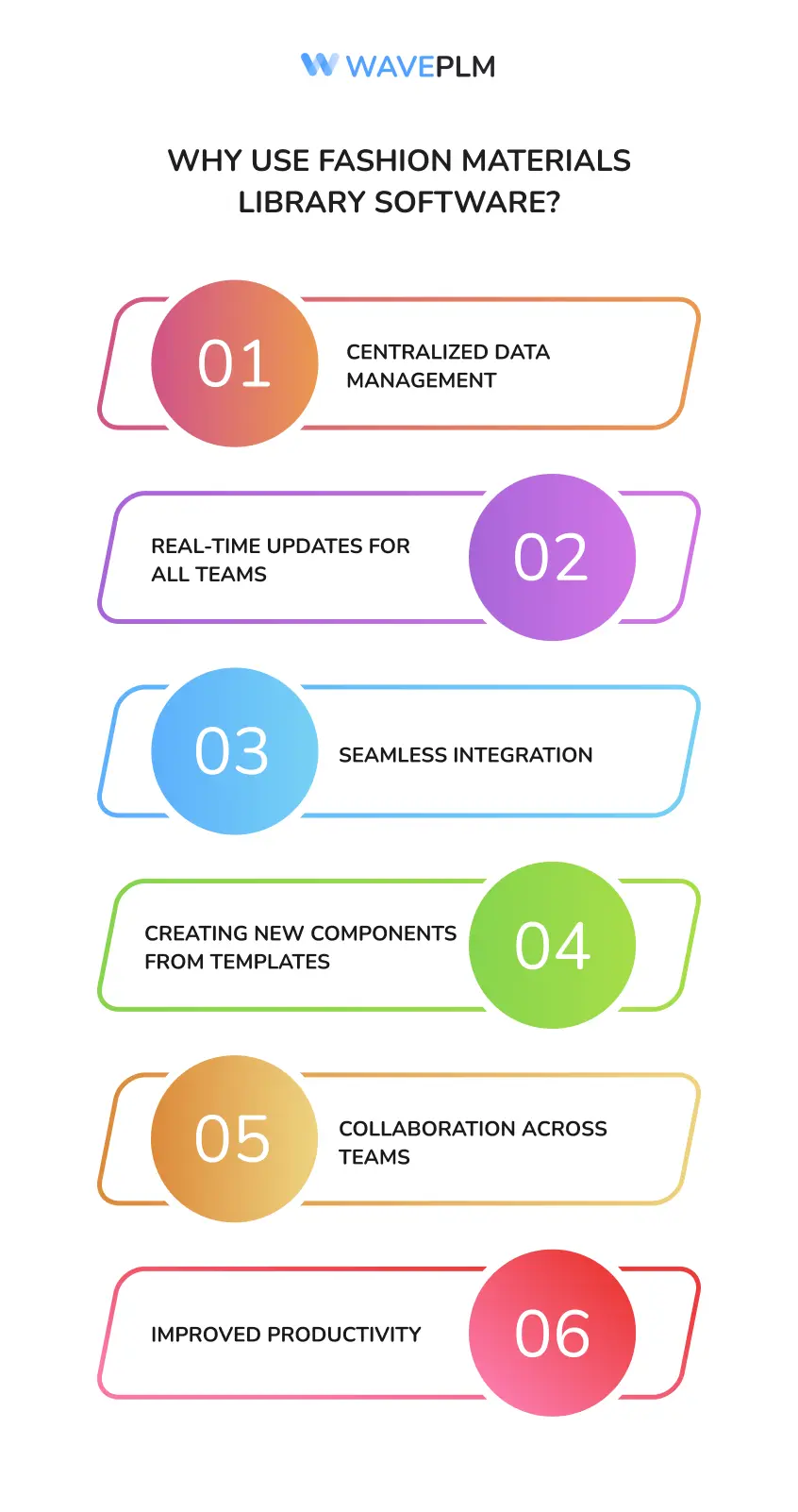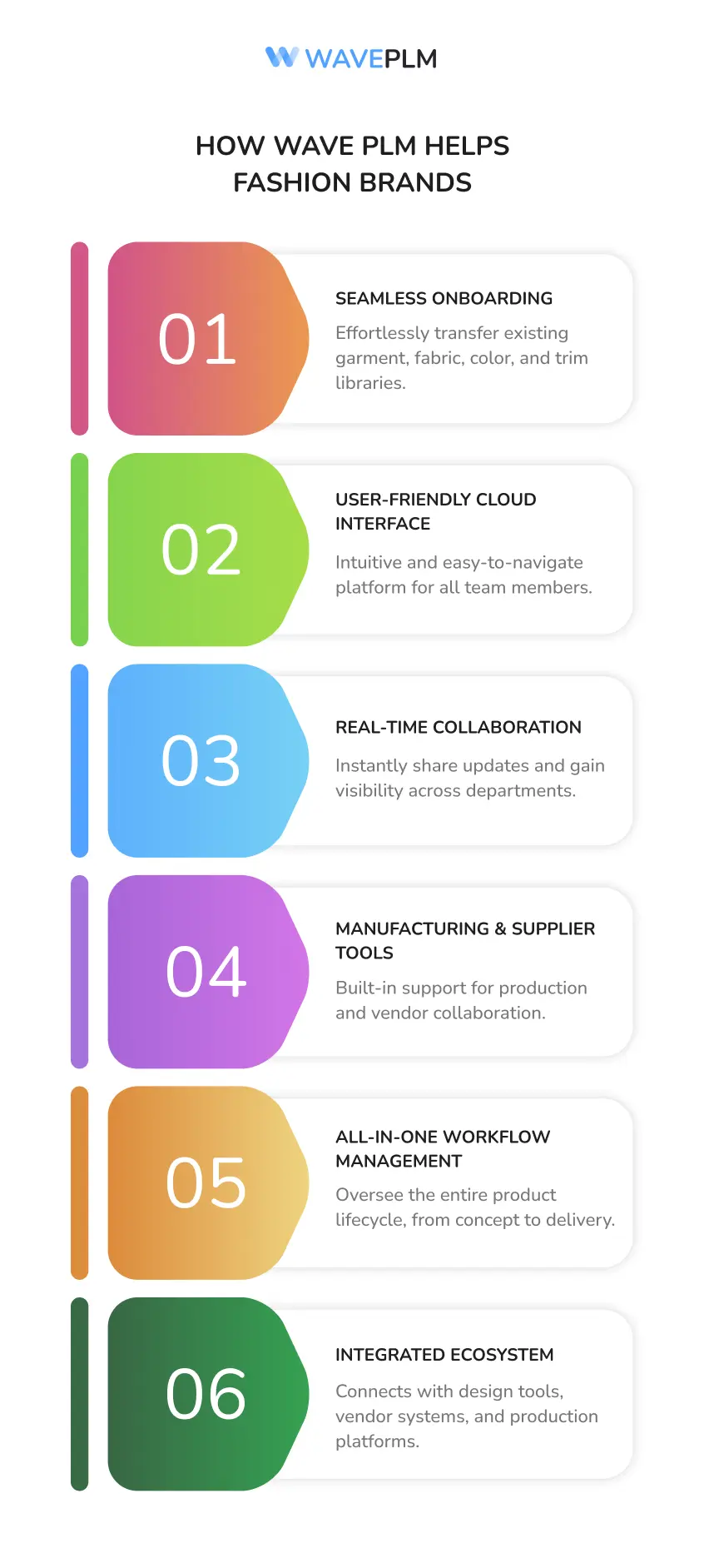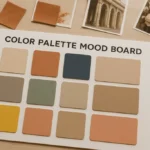
Fashion materials library
Managing materials, fabrics, trims, and colors for every fashion collection involves handling various parameters, making it a complex process. Teams face growing challenges when handling data, ensuring accuracy, and reusing information. Without proper tools, designers and developers spend hours tracking down resources. But this changes with the help of a well-organized fashion materials library software built into modern PLM software.
This article explains how fashion brands use digital libraries—including a garment library, fabric library, trim library, color library, and component library—to speed up development, reduce waste, and build stronger collections. With a cloud-based, user-friendly interface, brands enjoy better teamwork and clearer data flow.
Introduction to Fashion Design
Fashion design is a multifaceted process that involves creating clothing and accessories that are both aesthetically pleasing and functional. A crucial aspect of this process is selecting the right materials, which can be significantly streamlined by using a comprehensive material library. A material library is a curated collection of different materials, each with its own unique properties and characteristics. A comprehensive library provides access to an extensive range of materials, supporting detailed comparison and selection for various design needs.
Fashion designers can leverage a material library to explore and discover new materials, determining which ones are best suited for a particular project. By having access to a wide range of materials, designers can create innovative and sustainable designs that meet the needs of their clients. Material libraries can be either physical or digital and may include a variety of materials such as fabrics, textiles, and other components.
With a well-organized material library, designers can develop their own unique style and aesthetic while staying up-to-date with the latest trends and technologies. This resource helps designers work more efficiently and effectively, enabling them to create high-quality designs that fulfill their clients’ requirements.
What Is a Fashion Materials Library?
A fashion materials library is a centralized digital system used to manage all physical and virtual materials required for creating garments. It organizes each item by type, making it easy for teams to find, reuse, and update materials in real time. Users often find that essential materials are easily found and accessible, reducing the time spent searching for resources.
|
Library Type |
Description |
|---|---|
|
Garment Library |
Full garment styles, silhouettes, and patterns accessible across teams |
|
Fabric Library |
Material swatches with fiber content, weight, treatments, and sourcing info |
|
Color Library |
Brand-approved color palettes with codes, swatches, and linked items |
|
Trim Library |
Buttons, snaps, labels, zippers, and finishes with detailed specs |
|
Component Library |
Elements like sleeves, collars, cuffs, or plackets used in different designs |
These libraries act as building blocks for creative and technical teams. Instead of reinventing the wheel every season, brands reuse materials, resulting in faster development and fewer mistakes.
Creating a Comprehensive Repository
Creating a comprehensive material library requires a significant investment of time and effort, but it can become an invaluable resource for designers. A well-rounded repository should include a wide range of materials, each with distinct properties and characteristics. Organization is key; the repository should be easy to navigate, with clear labels and categories.
Designers can utilize various tools and software to create and manage their material library, such as database management systems and digital asset management tools. It’s also crucial to consider the sustainability and environmental impact of the materials included in the library, providing information about their origins and production processes.
A comprehensive material library can help designers create innovative and sustainable designs. By including a wide range of materials and detailed information about their properties, designers can make informed decisions about which materials to use for specific projects. Additionally, a well-maintained repository helps designers stay current with the latest trends and technologies, fostering the development of their unique style and aesthetic.
Why Use Fashion Materials Library Software?
Fashion collections involve many moving parts. Centralized fashion development tools are essential to reduce chaos and delays. Here’s why top brands use them:
- Centralized data management helps keep everything organized in one platform, giving teams better control over their material data.
- Real-time changes update instantly for all teams across locations.
- Seamless integration with design, sourcing, and development stages.
- Users can create new components using templates and existing data.
- Users can click through the interface to quickly locate and select materials or settings, streamlining the workflow.
- Collaboration across teams becomes smoother and faster.
- Improve productivity by cutting redundant tasks and enabling faster approvals.
Every detail matters, and keeping track of it all manually wastes time. By using a digital library, brands avoid bottlenecks and work smarter. The software allows users to save new materials, presets, or updates to the library, ensuring all changes are securely stored and easily accessible.

Why Use Fashion Materials Library Software
How the Library Fits into PLM Software
Modern product lifecycle management (PLM) platforms do more than manage product timelines. They include rich digital libraries that integrate with all parts of the design and development process. Libraries become the hub of every action, with material presets and settings seamlessly applied across different stages of the design and development process. Users can enter new material details or presets directly into the digital library, ensuring accurate and up-to-date information is available throughout the design and development process.
|
PLM Feature |
How It Supports the Library |
|---|---|
|
Digital Material Library |
Store, tag, and reuse fabric, trims, and color swatches |
|
Manage materials from any location at any time |
|
|
CAD Software Compatibility |
Use library content in computer-aided design tools easily |
|
Connect materials directly to vendors, costs, and lead times |
|
|
Realistic 3D Visualization |
Preview how materials look in 3D fashion design |
|
Collaboration Tools |
Share, review, and approve items in real time |
|
Product Data Sync |
Sync libraries with product BOMs and tech packs |
Everything stays in sync. From designers working in CAD to buyers negotiating with vendors, everyone works from the same source.
Collaboration and Communication Tools
A comprehensive material library is more than just a database—it’s a powerful platform for collaboration and communication among designers, architects, and engineers. By providing instant access to thousands of materials and their detailed properties, including mechanical properties, the library enables users to search, explore, and compare options with ease. This makes selecting the right material for any design or operation faster and more reliable.
The material library’s intuitive interface allows users to download, edit, and personalize material data, building a custom library that fits their unique project needs. With API access, teams can seamlessly integrate material data into their favorite design tools, ensuring that up-to-date information is always at their fingertips. This integration not only saves time but also increases the effectiveness of the entire design process.
Collaboration is further enhanced by the library’s ability to keep a record of past operations and experiments. Designers and architects can revisit previous material choices, learn from past projects, and refine their search and exploration strategies over time. Whether working with wood, metals, or advanced textiles, the comprehensive list of materials and their properties helps users make informed decisions quickly.
In addition, the material library serves as a shared platform for team communication. By centralizing material information, it ensures that everyone is working from the same data set, reducing errors and miscommunication. Team members can easily share insights, discuss options, and learn from each other’s experiences, helping to drive innovation and maintain consistency across projects.
Ultimately, the material library empowers users to search, select, and learn about thousands of materials in just a few clicks. Its easy-to-use design and robust data set make it an essential tool for any team aiming to streamline their workflow, boost effectiveness, and achieve outstanding results in design and engineering. Whether you’re managing a small project or a large-scale operation, the material library is your key to smarter, faster, and more collaborative material selection.
Implementing a New System
Implementing a new material library system can be a complex process, but it significantly enhances designers’ efficiency and effectiveness. The first step is to determine the needs and requirements of the designers who will be using the system. This can involve conducting surveys and interviews to gather information about the types of materials and data designers need to access.
Once the needs and requirements are clear, the next step is to select suitable software or tools for managing the material library. There are many options available, each with unique features and capabilities. It’s important to consider the scalability and flexibility of the system, ensuring it can be easily updated and expanded as needed.
Implementing a new system also involves training and supporting designers, providing them with the resources and information they need to use the system effectively. By adopting a new material library system, designers can improve their workflow and productivity, creating high-quality designs that meet their clients’ needs.
How Wave PLM Helps Fashion Brands
Wave PLM was initially designed to remove the clutter and stress from fashion product development. Its built-in fashion materials library software supports complete library migration and smart organization.
Here’s what makes Wave PLM stand out:
- Teams can transfer existing garment, fabric, color, and trim libraries during onboarding.
- Use a cloud-based interface that is easy to learn and navigate.
- Teams enjoy real-time visibility and updates across departments.
- Built-in tools support manufacturing servicing and supplier collaboration.
- Manage every stage—from concept to final delivery—within one system.
- Streamline the management and selection of materials for a wide range of fashion products, making it easier to organize product data and accelerate the entire product development process.
- This comprehensive approach ensures that brands are well-prepared for future developments and can easily adapt to new trends and technologies.
- Enjoy seamless integration with design tools, vendor systems, and production.
offers a free one-month trial. During this time, brands can explore how the platform transforms their workflows.

How Wave PLM Helps Fashion Brands
Best Practices for Data Management
Effective data management is critical for maintaining a comprehensive material library. This involves ensuring that all materials and information are accurately and consistently labeled and categorized. Establishing clear protocols for adding and removing materials from the library, as well as updating and revising existing information, is essential.
Designers should also implement a system for tracking and managing material samples, monitoring and controlling inventory levels. Regular backups and archives should be created to protect the material library in case of data loss or corruption.
By following best practices for data management, designers can ensure their material library is accurate, up-to-date, and easy to use. This improves workflow and productivity, enabling the creation of high-quality designs that meet clients’ needs. Effective data management also helps designers stay organized and focused, making informed decisions about which materials to use for specific projects.
Supply Chain Management
Supply chain management is a crucial aspect of material library management, ensuring that materials are sourced and procured responsibly and sustainably. Designers should consider the environmental and social impact of the materials they use, striving to source materials from suppliers who share their values and commitment to sustainability.
This involves researching and evaluating different suppliers, establishing relationships with those who meet the designer’s standards and requirements. Supply chain management also includes implementing systems for tracking and managing material inventory, monitoring and controlling waste and excess materials.
By managing their supply chain effectively, designers can reduce their environmental impact and create high-quality designs that meet their clients’ needs. Effective supply chain management improves workflow and productivity, reduces costs, and enhances efficiency. By working closely with suppliers and stakeholders, designers can ensure their material library is comprehensive, up-to-date, and easy to use. This approach helps designers stay competitive and innovative, creating designs that are both sustainable and stylish.
Template: Build Your Own Digital Fashion Library
Getting started with building your own digital fashion library can be simplified by using a structured template.
Use this sample format to begin structuring your material database:
|
Library Category |
Example Entry |
Fields to Include |
|---|---|---|
|
Fabric |
Organic Cotton Jersey |
Fiber, Weight (GSM), Width, Colors, Supplier, Price, Lead Time |
|
Trim |
Branded Recycled Zipper |
Type, Size, Finish, Material, Supplier, MOQ |
|
Color |
SS26 Olive Grove |
Pantone Code, RGB/HEX, Associated Materials, Seasonal Category |
|
Component |
Standard Shirt Collar #22 |
Style ID, Material, Pattern Ref, Compatible Garments |
|
Garment |
Women’s Oversized Blazer |
Style Code, Sizes, Material List, Season, Target Price, Designer |
Standardizing entries like these ensures better data management and faster sourcing.
Real Benefits for Every Team
Each team gains real advantages by working from a centralized digital library.
|
Team |
Benefits |
|---|---|
|
Design |
Access to full material palettes and trims while creating new styles |
|
Product Dev |
Combine components for faster prototyping and tech pack creation |
|
Sourcing |
Track material costs and vendor details in one place |
|
Production |
Pull updated BOMs and manufacturing specs from the library |
|
Marketing |
Use accurate visuals and color data in product listings and campaigns |
|
Merchandising |
Plan assortments around approved materials and past-season data |
Libraries bring transparency, clarity, and speed to every touchpoint in the product lifecycle.
Smarter, Cleaner, and Faster Production Process
When brands use a digital library inside their PLM, the production process becomes more agile:
- Teams reuse approved items for various operations rather than rebuild them each season.
- Fewer errors mean less waste, better quality, and faster delivery.
- Teams stay aligned even as they scale collections.
- Strong supply chain management through vendor-linked material data.
- Quicker design and development cycles using consistent materials.
Better systems allow teams to focus on creativity, not corrections.
Summary: Why a Fashion Materials Library Matters
Today’s fashion brands need flexible, digital-first systems to stay competitive. A strong fashion materials library software is not optional—it’s essential. Such a system not only enhances efficiency but also allows for the evaluation and improvement of material performance, ensuring high-quality outcomes.
With a well-maintained garment library, component library, and color library inside your PLM software, you get better consistency, faster turnaround, and fewer errors. Teams can easily reuse successful materials and scale faster with data-driven decisions.
Wave PLM provides all of this with a clean, user-friendly interface, seamless CAD software integration, and tools designed for real-time collaboration across teams.
If you’re looking to boost your fashion development workflow, reduce waste, and improve consistency, Wave PLM offers the smartest start.
Start your journey today. Sign up for a free 30-day trial and experience better material management.




